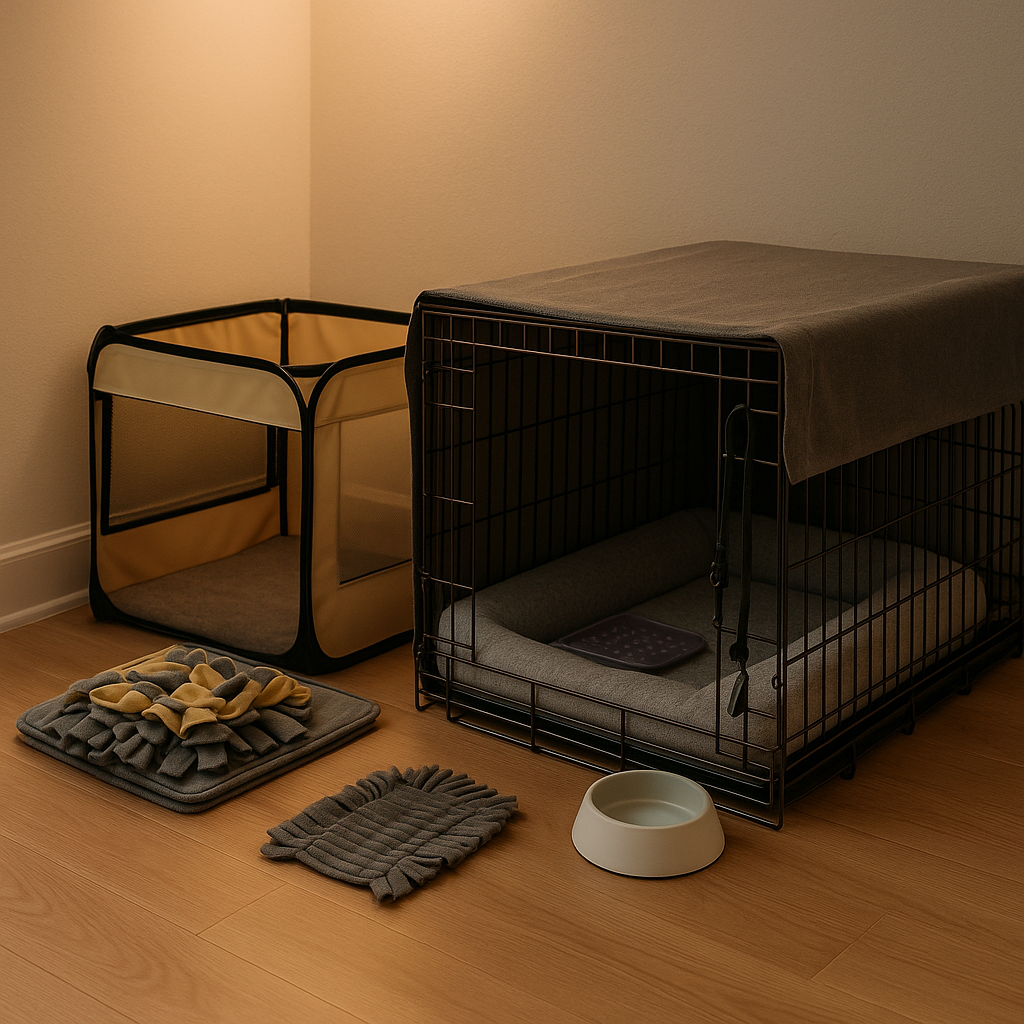
The Gentle Den: A 21-Day Compassion-First Crate Training Blueprint (Gear, Rituals & Troubleshooting) | FurrHavens
Share
Prologue
A good crate is not a cage; it is architecture for calm—a door you can leave open to invite rest, a boundary that lowers arousal, a refuge that teaches self-soothing. When sized, furnished, and introduced with dignity, a crate becomes a den; the dog chooses it, not merely tolerates it. Here is a precise, humane, 21-day plan—with gear you can set up in an afternoon and habits that last for years.
1) The Right Gear (and why each piece matters)
-
Crate (wire or furniture-style): size so the dog can stand, turn, and lie extended—not a ballroom, not a shoebox. Consider a divider panel for puppies who will grow.
-
Crate Cover or Side Panels: creates a three-wall “cave” to reduce visual noise; leave the front open at first.
-
Orthopedic or gel-foam bed (washable cover) or chew-resistant mat for teething pups.
-
Lick mat / snuffle mat / long-lasting chew: turns time into calm work; licking and sniffing lower heart rate.
-
Water plan: a no-spill bowl outside the crate + brief water breaks; inside bowls only for medical needs.
-
Playpen or baby gate: for the outside-den zone when you need semi-supervised time.
-
Potty pads / bell / enzyme cleaner: for house-training and honest cleanup (odor matters).
-
Calming aids: breathable calming shirt, pheromone diffuser, or soothing chew if your vet approves.
Placement: Choose a quiet, lived-in corner—near family hum, away from slamming doors and direct HVAC. The den is close to life, not in exile.
2) The 21-Day Blueprint (copy-ready)
Phase I — Association & Choice (Days 1–7)
Goal: Crate = predictable good things.
-
Door always open. Scatter three kibbles inside after every short play burst.
-
Name the den: “Home” or “Den.” Soft voice, short cue.
-
Meals in the doorway → inside: Day 1–2 bowl at threshold; by Day 3–4 just inside; by Day 5–7 fully inside.
-
Calm work: smear a lick mat and place it just beyond the threshold; let the dog choose to step in.
-
Micro-rests: after walks, drop a snuffle mat inside; 2–4 minutes of sniffing → brief nap.
-
Night plan (puppies): crate bedside; set alarm for potty rather than waiting for fussing. Quiet lift → potty spot → back to bed. No midnight party.
Checkpoint by Day 7: Dog enters easily for food/lick time; lies down on own at least once daily. No forced closing yet.
Phase II — Comfortable Closure (Days 8–14)
Goal: Closed door = predictable, short, calm sessions.
-
First closes (30–90 sec): cue “Home,” drop a few kibbles, close door, lean nearby; open before restlessness. Increase to 2–3 minutes.
-
Patterned exits: door opens when calm (four paws down, quiet mouth). Excited greetings wait two beats.
-
Distance reps: sit 2–3 steps away, then 5–8; fold laundry, answer an email—nearby but not hovering.
-
Anchor ritual: crate time after a known routine (walk → water → potty → lick mat → den). Consistency predicts success.
-
Naps with cover: drape two sides to lower light; keep front open until the dog visibly settles faster with the cover.
Checkpoint by Day 14: Dog accepts 5–10 minute closings with a chew/lick; settles within ~2 minutes; exits are low-drama.
Phase III — Real-Life Durations (Days 15–21)
Goal: Den works while you shower, take calls, or run short errands.
-
Build the clock: 5 → 10 → 15 → 30 minutes across the week. Add soft background noise (fan or brown noise).
-
Leave & return etiquette: keys/jacket on silently; one cue (“Back soon”). On return, no fireworks—open calmly once four paws and a quiet face appear.
-
Transfer skill: use the playpen as a secondary calm space with a bed and chew; alternate so the crate isn’t the only boundary.
-
Night expansion (adults): if sleeps through, move crate gradually farther from bed or to the intended long-term spot.
Graduation criteria: 30–45 minutes of calm with a chew, predictable naps after exertion, quiet entries/exits, and no bathroom accidents linked to crate time.
3) House-Training with the Den (puppies & new rescues)
-
Rhythm: Wake → potty → play → train → crate with lick → nap → potty → repeat.
-
Intervals (young pups): 1 hour per month of age (up to ~4 hours) when awake; naps reset the clock.
-
Signals: sniffing, circling, sudden quiet. If in doubt, escort to potty spot; praise a successful mark.
-
Accident protocol: no scolding; enzyme clean immediately; adjust the previous interval (you learned the dog’s real clock).
-
Water: balanced access. Remove bowls ~2 hours before bed (pups), but offer small sips after play and before crating.
4) Anxiety, Barking & Whining: Diagnostics → Fixes
Symptom: whine within 30–60 seconds of closing
-
Likely: duration jump too big; energy not spent.
-
Fix: cut session time in half; add 5–7 minutes sniff/hunt before closing; open only during 3 seconds of quiet.
Symptom: frantic pawing at door
-
Likely: cover too soon, crate too far from you, or high arousal preceding.
-
Fix: move den closer, uncover front, switch to snuffle (not high-value chew) and reduce pre-crate hype.
Symptom: silence → then explosive bark at your return
-
Likely: rehearsed pattern.
-
Fix: vary return timing; stand/sit in room for 1 minute before opening; open only when ears/eyes are soft.
Symptom: toileting in crate
-
Likely: intervals too long, size too large, or illness.
-
Fix: add divider, tighten potty schedule, vet check if persistent.
If the dog shows panic (saliva floods, escape chewing, self-injury), stop and consult a fear-free trainer or veterinarian. Severe separation anxiety requires a tailored plan; the den alone is not the cure.
5) Den Furnishing & Hygiene (so comfort lasts)
-
Bedding: choose orthopedic for adults/seniors; chew-resistant pad for teething. Wash covers weekly; sun-air the foam when possible.
-
Rotation: keep two lick mats and two chews in rotation; novelty lowers protest.
-
Scent layering: place a worn T-shirt (no strings) for the first week; remove once calm habits form.
-
Clean cycle: wipe crate bars and tray with pet-safe cleaner; launder covers 1×/week; replace chews before fray becomes hazard.
6) Travel & Vet Days (den skills that transfer)
-
Carrier/crate continuity: same cue (“Home”), same mat inside. Start with driveway sits (car off), then short loops, then real rides.
-
Vet rehearse: 3–5 days before, practice brief door closes with a stethoscope sound playlist at low volume; reward stillness.
-
Hotel or friend’s house: bring cover and mat; set up in a quiet corner; first session short, then grow.
7) Multi-Dog Homes (fairness is architecture)
-
One den per dog. Loans are allowed, but ownership is singular.
-
Staggered entries/exits—each dog gets a calm opening.
-
Resource guards: feed high-value chews inside the den, doors closed; collect remains before opening.
8) Daily Schedules (two copy-ready options)
A) Puppy (12–16 weeks)
-
7:00 Wake → potty → 10 min sniff play
-
7:20 Breakfast in crate (door open) → short cuddle
-
8:00 Potty → 5 min training (sit, name) → Den 20–30 min with lick mat → nap
-
9:00 Potty → gentle walk → free time
-
Noon Lunch → Den 30–45 min → nap
-
2:30 Potty → playpen time with chew
-
5:30 Dinner → sniff walk → Den 30–45 min
-
9:30 Final potty → bedside crate, cover two sides
B) Adult Dog (balanced workday)
-
Morning walk (20–30 min) → breakfast → Den 30 min while you prep
-
Midday potty break → sniffy scatter feed → short Den 15–20 min
-
Evening exercise (fetch/hike) → Den 20–30 min cool-down while you dine
-
Lights-out routine → optional open-door den with bed
9) Troubleshooting Quick Table (symptom → cause → fix)
-
Mouthy at door → anticipates release → wait 3 seconds calm, then open; practice fake approaches without opening.
-
Won’t enter unless food present → cue not fluent → run 10 rapid “in–out” reps with low-value kibble, then one with praise only.
-
Paces in crate at night → room too bright/noisy → add cover + white noise, shift den closer for three nights.
-
Shreds bed → under-exercised/teething → swap to chew-proof mat, add frozen chew; increase daytime sniff sessions.
FAQ
Q: Wire or furniture-style crate?
A: Wire is airy and modular (add a divider, easy to cover). Furniture crates integrate into living spaces and reduce visual clutter. Choose ventilation first, looks second.*
Q: How long can an adult dog stay crated?
A: Regularly no more than 4–5 waking hours without a break. Night sleep is separate if the dog is settled and comfortable.*
Q: Should water be inside?
A: For most healthy dogs, offer water between den sessions and on scheduled breaks. Inside bowls can spill and dampen bedding; use only if medically indicated.*
Q: Is crying “letting them cry it out” okay?
A: No. We reinforce calm, not distress. Shorten duration, sweeten the entry (sniff/lick), and open only during calm—that teaches the right lesson.*
Epilogue / CTA
Make serenity inevitable: size the crate with care, furnish it with comfort, pair it with sniffing and licking work, and keep every exit dignified. Outfit your den with FurrHavens—crates & covers, orthopedic beds, playpens & gates, lick/snuffle mats, long-lasting chews, no-spill bowls, potty pads, and enzyme cleaners—then let the next 21 days turn routine into refuge.
